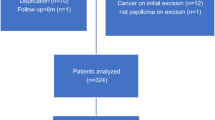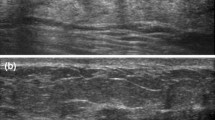Abstract
To evaluate whether the upgrade-to-malignancy rate of benign papillary lesions on ultrasonographically (US)-guided 14-gage core needle biopsy (CNB) can be decreased using immunohistochemistry staining (IHC) for pathologic diagnosis, and to determine whether additional IHC can replace surgical excision for the diagnosis of papillary breast lesions classified as benign on 14-gage CNB. A total of 274 consecutive papillary lesions were studied, including available imaging findings, CNB specimens and surgical specimens. Two rounds of retrospective review of the pathologic slides from CNB were performed by a pathologist, including H&E staining (first round; 1R, n = 274) and IHC of the benign papillomas (second round; 2R). The upgrade-to-malignancy rate was assessed for benign papillomas with comparison between 1R and 2R. The final diagnosis was based on surgical pathology. The clinicoradiologic findings were compared between the benign and malignant papillomas at the time of final diagnosis. In 1R, 204 benign papillomas were identified. During 2R using IHC, three carcinomas and ten atypical papillomas were diagnosed. Among the 204 benign papillomas from 1R, 15 were found to be carcinomas (upgrade-to-malignancy rate, 7.4 %) at the time of final diagnosis. With 2R, the overall upgrade-to-malignancy rate was decreased to 4.7 % (9/192, p = 0.3680). Older age and upgrades made after IHC review resulted in higher upgrade-to-malignancy rates (odds ratio, 4.133, 95 % CI 1.393–12.267, p = 0.0106; 134.46, 95 % CI 17.886–infinity, p < 0.0001, respectively). The use of IHC may decrease the upgrade-to-malignancy rate for benign papillary lesions after US-guided 14-gage CNB and help to more accurately predict malignancy at the time of surgery. Despite these findings, a misdiagnosis still occurred in our study, suggesting that IHC cannot replace surgical excision for diagnosis of benign papillary lesions of the breast.




Similar content being viewed by others
References
Tavassoli FA, Schnitt SJ (1992) Pathology of the breast. Elsevier, New York, pp 193–227
Fenoglio C, Lattes R (1974) Sclerosing papillary proliferations in the female breast. A benign lesion often mistaken for carcinoma. Cancer 33:691–700
Kraus FT, Neubecker RD (1962) The differential diagnosis of papillary tumors of the breast. Cancer 15:444–455
Liberman L, Tornos C, Huzjan R, Bartella L, Morris EA, Dershaw DD (2006) Is surgical excision warranted after benign, concordant diagnosis of papilloma at percutaneous breast biopsy? AJR Am J Roentgenol 186:1328–1334
Mercado CL, Hamele-Bena D, Oken SM, Singer CI, Cangiarella J (2006) Papillary lesions of the breast at percutaneous core-needle biopsy. Radiology 238:801–808
Puglisi F, Zuiani C, Bazzocchi M, Valent F, Aprile G, Pertoldi B, Minisini AM, Cedolini C, Londero V, Piga A, Di Loreto C (2003) Role of mammography, ultrasound and large core biopsy in the diagnostic evaluation of papillary breast lesions. Oncology 65:311–315
Liberman L, Bracero N, Vuolo MA, Dershaw DD, Morris EA, Abramson AF, Rosen PP (1999) Percutaneous large-core biopsy of papillary breast lesions. AJR Am J Roentgenol 172:331–337
Irfan K, Brem RF (2002) Surgical and mammographic follow-up of papillary lesions and atypical lobular hyperplasia diagnosed with stereotactic vacuum-assisted biopsy. Breast J 8:230–233
Ivan D, Selinko V, Sahin AA, Sneige N, Middleton LP (2004) Accuracy of core needle biopsy diagnosis in assessing papillary breast lesions: histologic predictors of malignancy. Mod Pathol 17:165–171
Ahmadiyeh N, Stoleru MA, Raza S, Lester SC, Golshan M (2009) Management of intraductal papillomas of the breast: an analysis of 129 cases and their outcome. Ann Surg Oncol 16:2264–2269
Al Sarakbi W, Worku D, Escobar P, Mokbel K (2006) Breast papillomas: current management with a focus on a new diagnostic and therapeutic modality. Int Semin Surg Oncol 3:1
Kim MJ, Kim EK, Kwak JY, Son EJ, Park BW, Kim SI, Oh KK (2008) Nonmalignant papillary lesions of the breast at US-guided directional vacuum-assisted removal: a preliminary report. Eur Radiol 18:1774–1783
Kim MJ, Kim SI, Youk JH, Moon HJ, Kwak JY, Park BW, Kim EK (2011) The diagnosis of non-malignant papillary lesions of the breast: comparison of ultrasound-guided automated gun biopsy and vacuum-assisted removal. Clin Radiol 66:530–535
Mercado CL, Hamele-Bena D, Singer C, Koenigsberg T, Pile-Spellman E, Higgins H, Smith SJ (2001) Papillary lesions of the breast: evaluation with stereotactic directional vacuum-assisted biopsy. Radiology 221:650–655
Sohn V, Keylock J, Arthurs Z, Wilson A, Herbert G, Perry J, Eckert M, Smith D, Groo S, Brown T (2007) Breast papillomas in the era of percutaneous needle biopsy. Ann Surg Oncol 14:2979–2984
Furuya C, Kawano H, Yamanouchi T, Oga A, Ueda J, Takahashi M (2012) Combined evaluation of CK5/6, ER, p63, and MUC3 for distinguishing breast intraductal papilloma from ductal carcinoma in situ. Pathol Int 62:381–390
Grin A, O’Malley FP, Mulligan AM (2009) Cytokeratin 5 and estrogen receptor immunohistochemistry as a useful adjunct in identifying atypical papillary lesions on breast needle core biopsy. Am J Surg Pathol 33:1615–1623
Schnitt SJ, Collins LC (2008) Biopsy interpretation of the breast. Wolters Kluwer/Lippincott Williams & Wilkins, Philadelphia
Philpotts LE, Shaheen NA, Jain KS, Carter D, Lee CH (2000) Uncommon high-risk lesions of the breast diagnosed at stereotactic core-needle biopsy: clinical importance. Radiology 216:831–837
Rosen EL, Bentley RC, Baker JA, Soo MS (2002) Imaging-guided core needle biopsy of papillary lesions of the breast. AJR Am J Roentgenol 179:1185–1192
Agoff SN, Lawton TJ (2004) Papillary lesions of the breast with and without atypical ductal hyperplasia: can we accurately predict benign behavior from core needle biopsy? Am J Clin Pathol 122:440–443
Bode MK, Rissanen T, Apaja-Sarkkinen M (2009) Ultrasonography-guided core needle biopsy in differential diagnosis of papillary breast tumors. Acta Radiol 50:722–729
Chang JM, Moon WK, Cho N, Han W, Noh DY, Park IA, Jung EJ (2010) Risk of carcinoma after subsequent excision of benign papilloma initially diagnosed with an ultrasound (US)-guided 14-gauge core needle biopsy: a prospective observational study. Eur Radiol 20:1093–1100
Chang JM, Moon WK, Cho N, Han W, Noh DY, Park IA, Jung EJ (2011) Management of ultrasonographically detected benign papillomas of the breast at core needle biopsy. AJR Am J Roentgenol 196:723–729
Ko ES, Cho N, Cha JH, Park JS, Kim SM, Moon WK (2007) Sonographically-guided 14-gauge core needle biopsy for papillary lesions of the breast. Korean J Radiol 8:206–211
Sydnor MK, Wilson JD, Hijaz TA, Massey HD, Shaw de Paredes ES (2007) Underestimation of the presence of breast carcinoma in papillary lesions initially diagnosed at core-needle biopsy. Radiology 242:58–62
Tseng HS, Chen YL, Chen ST, Wu YC, Kuo SJ, Chen LS, Wu HK, Chen DR (2009) The management of papillary lesion of the breast by core needle biopsy. Eur J Surg Oncol 35:21–24
Youk JH, Kim EK, Kwak JY, Son EJ, Park BW, Kim SI (2011) Benign papilloma without atypia diagnosed at US-guided 14-gauge core-needle biopsy: clinical and US features predictive of upgrade to malignancy. Radiology 258:81–88
Chang JM, Han W, Moon WK, Cho N, Noh DY, Park IA, Jung EJ (2011) Papillary lesions initially diagnosed at ultrasound-guided vacuum-assisted breast biopsy: rate of malignancy based on subsequent surgical excision. Ann Surg Oncol 18:2506–2514
Cheng TY, Chen CM, Lee MY, Lin KJ, Hung CF, Yang PS, Yu BL, Yang CE, Tsai TJ, Lin CW (2009) Risk factors associated with conversion from nonmalignant to malignant diagnosis after surgical excision of breast papillary lesions. Ann Surg Oncol 16:3375–3379
Kil WH, Cho EY, Kim JH, Nam SJ, Yang JH (2008) Is surgical excision necessary in benign papillary lesions initially diagnosed at core biopsy? Breast 17:258–262
Rizzo M, Linebarger J, Lowe MC, Pan L, Gabram SG, Vasquez L, Cohen MA, Mosunjac M (2012) Management of papillary breast lesions diagnosed on core-needle biopsy: clinical pathologic and radiologic analysis of 276 cases with surgical follow-up. J Am Coll Surg 214:280–287
Plantade R, Gerard F, Hammou JC (2006) Management of non malignant papillary lesions diagnosed on percutaneous biopsy. J Radiol 87:299–305
Skandarajah AR, Field L, Yuen Larn Mou A, Buchanan M, Evans J, Hart S, Mann GB (2008) Benign papilloma on core biopsy requires surgical excision. Ann Surg Oncol 15:2272–2277
Bernik SF, Troob S, Ying BL, Simpson SA, Axelrod DM, Siegel B, Moncrief RM, Mills C, Aziz M (2009) Papillary lesions of the breast diagnosed by core needle biopsy: 71 cases with surgical follow-up. Am J Surg 197:473–478
Collins LC, Schnitt SJ (2008) Papillary lesions of the breast: selected diagnostic and management issues. Histopathology 52:20–29
Jakate K, De Brot M, Goldberg F, Muradali D, O’Malley FP, Mulligan AM (2012) Papillary lesions of the breast: impact of breast pathology subspecialization on core biopsy and excision diagnoses. Am J Surg Pathol 36:544–551
Tan PH, Aw MY, Yip G, Bay BH, Sii LH, Murugaya S, Tse GM (2005) Cytokeratins in papillary lesions of the breast: is there a role in distinguishing intraductal papilloma from papillary ductal carcinoma in situ? Am J Surg Pathol 29:625–632
Shah VI, Flowers CI, Douglas-Jones AG, Dallimore NS, Rashid M (2006) Immunohistochemistry increases the accuracy of diagnosis of benign papillary lesions in breast core needle biopsy specimens. Histopathology 48:683–691
Koo JS, Kim MJ, Kim EK, Park BW (2012) Comparison of immunohistochemical staining in breast papillary neoplasms of cytokeratin 5/6 and p63 in core needle biopsies and surgical excisions. Appl Immunohistochem Mol Morphol 20:108–115
Pathmanathan N, Albertini AF, Provan PJ, Milliken JS, Salisbury EL, Bilous AM, Byth K, Balleine RL (2010) Diagnostic evaluation of papillary lesions of the breast on core biopsy. Mod Pathol 23:1021–1028
Tse GM, Tan PH, Moriya T (2009) The role of immunohistochemistry in the differential diagnosis of papillary lesions of the breast. J Clin Pathol 62:407–413
Tse GM, Tan PH, Lacambra MD, Jara-Lazaro AR, Chan SK, Lui PC, Ma TK, Vong JS, Ng DC, Shi HJ, Lam WW (2010) Papillary lesions of the breast—accuracy of core biopsy. Histopathology 56:481–488
Tse GM, Tan PH, Lui PC, Gilks CB, Poon CS, Ma TK, Law BK, Lam WW (2007) The role of immunohistochemistry for smooth-muscle actin, p63, CD10 and cytokeratin 14 in the differential diagnosis of papillary lesions of the breast. J Clin Pathol 60:315–320
Douglas-Jones A, Shah V, Morgan J, Dallimore N, Rashid M (2005) Observer variability in the histopathological reporting of core biopsies of papillary breast lesions is reduced by the use of immunohistochemistry for CK5/6, calponin and p63. Histopathology 47:202–208
Elston CW, Sloane JP, Amendoeira I, Apostolikas N, Bellocq JP, Bianchi S, Boecker W, Bussolati G, Coleman D, Connolly CE, Dervan P, Drijkoningen M, Eusebi V, Faverly D, Holland R, Jacquemier J, Lacerda M, Martinez-Penuela J, de Miguel C, Mossi S, Munt C, Peterse JL, Rank F, Reiner A, Sylvan M, Wells CA, Zafrani B (2000) Causes of inconsistency in diagnosing and classifying intraductal proliferations of the breast. European Commission Working Group on Breast Screening Pathology. Eur J Cancer 36:1769–1772
Jain RK, Mehta R, Dimitrov R, Larsson LG, Musto PM, Hodges KB, Ulbright TM, Hattab EM, Agaram N, Idrees MT, Badve S (2011) Atypical ductal hyperplasia: interobserver and intraobserver variability. Mod Pathol 24:917–923
Wen X, Cheng W (2012) Nonmalignant breast papillary lesions at core-needle biopsy: a meta-analysis of underestimation and influencing factors. Ann Surg Oncol 20:94–101
Carder PJ, Khan T, Burrows P, Sharma N (2008) Large volume “mammotome” biopsy may reduce the need for diagnostic surgery in papillary lesions of the breast. J Clin Pathol 61:928–933
Zografos GC, Zagouri F, Sergentanis TN, Nonni A, Michalopoulos NV, Kontogianni P, Koulocheri D, Dimitriadis IE, Bramis J, Patsouris E (2008) Diagnosing papillary lesions using vacuum-assisted breast biopsy: should conservative or surgical management follow? Onkologie 31:653–656
Acknowledgments
This study was supported by a BumSuk Academic Research fund of 2009.
Conflict of interest
None.
Author information
Authors and Affiliations
Corresponding author
Rights and permissions
About this article
Cite this article
Koo, J.S., Han, K., Kim, M.J. et al. Can additional immunohistochemistry staining replace the surgical excision for the diagnosis of papillary breast lesions classified as benign on 14-gage core needle biopsy?. Breast Cancer Res Treat 137, 797–806 (2013). https://doi.org/10.1007/s10549-012-2403-z
Received:
Accepted:
Published:
Issue Date:
DOI: https://doi.org/10.1007/s10549-012-2403-z




